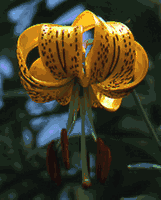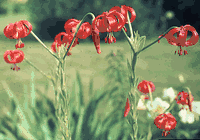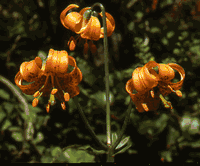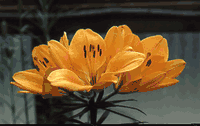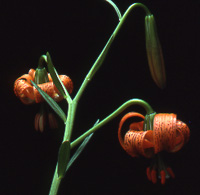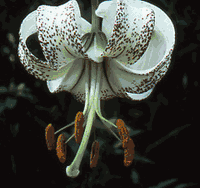Lilybulb.com - by B&D Lilies®
First in Garden Lilies... Since 1978Wild Lilies - Knowledge Base on the Lilium Species

This is only a partial list of Lilium species, to see more of the Wild Lily Knowledgebase CLICK HERE to be directed to our main website (www.bdlilies.com) Note: This database is public service only, not part of our on-line store.
Wild Lily bulbs making up the genus Lilium belong to the family Liliaceae comprising of approximately 200 genera made up of approximately 2,000 lily species. There are in the neighborhood of 110 to 120 lilium species depending on whose classification you reference. During the past few years, a number of “new” Lilium species have been exported out of China from wild stands of lily bulbs, many still waiting to be properly classified. To think that every river valley or mountain side has been explored and there is nothing left to find is a mistake, opportunities still await the plant adventurer. (To view photographs as a group, without the written descriptions, go to Lily Species Photo Gallery You can click on any photo for more details, useful if you are trying to identify a variety you have growing in your garden.)
As with so many familiar plants in our gardens, we often wonder, where they came from and how were they created into so many lovely and varied forms. As we trace ancestral lines back on every lily hybrid, we eventually find that its origin was two species, sometimes a cross made by nature herself, but more commonly, one made by man. We find a wonderful array of color and flower forms in nature’s creations. A journey back to the lily species that made your hybrid bulbs will lead you across the entire Northern Hemisphere. From the plains, mountains, and swamps of North America to the sub-tropical jungles of Burma; the harsh regions of Siberia to the rolling grasslands of Greece and the plains and valleys of all Europe; to high in the Himalayas to the stormy beach grasses of northern Japan. We find tiny dime-sized dangling flowers to huge blooms, the size of a dinner plate. In the lilies of the wild, gardeners find nature’s full rainbow of colors, white, pink, red, orange, yellow, and cream, but no blue tones, the genetics are simply not there.
Many gardeners after having grown and marveled at hybrid lily bulbs begin to wonder about the original species, endeavoring to include them in the garden. As the years have passed, commercial growers of lilies have mostly taken pure species out of their production fields. In the first half of the 20th Century, catalogs specializing in lilies were full of species offerings as there were few hybrids available. Most of these came by way of English, Dutch and German growers.
In the United States, the name Edgar Kline was synonymous with where to go for Lilium species. With the increased number of new hybrids requiring less toil in the garden, purity gardens with only wild collected or nursery propagated lily bulbs started to be forgotten. With the end of the 20th Century, as more and more gardeners began seeking the simpler times of the past and a return to their “roots” so to speak, a renewed interest in Lilium has occurred. As interest once again grows, the specialty grower is faced with “do I invest seven to twelve years to get crops up to numbers and size and will there still be a demand fifteen years and beyond if I do?” Yes, perhaps now, Lilium pumilum at four dollars each will be popular, but what about Lilium kelloggii , Lilium ciliatum , or Lilium ocellatum at twenty dollars per bulb?
Unfortunately, species lily bulbs commonly found just a mere twenty five years ago are virtually unheard of now by even the most avid gardeners. Even more tragic is the destruction of so many native stands worldwide in the name of progress. It is safe to say that we will never again see the availability of these rare beauties for the garden that our parents and grandparents enjoyed. Unfortunately, the wild lilies fell by the wayside for the less temperamental and nearly foolproof hybrids for a new generation of gardeners.
Requiring much more attention and time, it finally comes down to what is cost effective for the commercial grower and what is not. Though there is a constant and steady demand for the species, it is not great enough to “pay the bills”. Those specialists still producing Lilium species bulbs are the people who are willing to spend sometimes as many as seven or eight years to produce a flowering size bulb from a seed and then another couple years to get some size on the bulbs so they will produce multiple flowers after being moved to their new garden home. As a result of this investment of time, we must expect and be willing to often pay dearly for their efforts to include these rare marvels in our gardens.
Recently, several species not seen in the market place for many years are now being produced from a few small growers in Holland. The downside is that they are being marketed no differently than hybrid garden lilies and failure rates are high. Lilium cernuum along with the white colored variant ‘candidum’ as well as Lilium nepalense have very exacting requirements for successful growth. Unfortunately the catalogers often promoting themselves as “experts” are not propagators but are merely jobbers and do not provide proper growing instructions. It is easier to offer “no guarantee” for successful growth than to take the time to learn about what they are buying from brokers for resale. In the case of both the above mentioned species, each has one very simple, though different, “secret” for success. Not being actual propagators of these lily bulbs, they have no idea as to the secrets of success and are unable to properly instruct their customers.
Before you decide to try your hand with the wild ones, it is best to become familiar with their special requirements. Varieties such as Lilium henryi , Lilium speciosum , Lilium auratum , Lilium pumilum , Lilium superbum , Lilium canadense , Lilium pardalinum , Lilium regale , Lilium bulbiferum , and Lilium dauricum , are considered to be quite easy and will forgive you, as with most garden hybrids, if conditions are not exact from year to year. Unfortunately the number of forgiving Lilium species is quite small. Once having grown and succeeded with these and armed with the confidence of success, you may want to venture out into the slightly more difficult. Lilium amabile , Lilium monadelphum , Lilium szovitsianum , Lilium concolor , Lilium hansonii , and Lilium tsingtauense .
All lily bulb species have special needs and with some preparation, most of us can find that special place in our garden that offers a chance at success. To start, a soil with porous gravel subsoil, permitting the essential sub drainage that species require and have in nature is a must. This is the first and a key element, but not the final answer. EVERY species has its own, special requirements for success. One of the aims in the successful cultivation of lily bulb species is to provide a deep and cool root run that will store the necessary moisture, but one that will not hold excessive amounts of water during their resting period in late fall and through the winter.
You must mimic nature as closely as possible if you are to expect even marginal success with the more difficult subjects, and again, providing the proper soil mix is only the beginning. In nature we find most species with their heads in the sun, and a low growing, native ground cover keeping the bulbs cool. Their need for an accompanying, protective ground cover in most cases is essential. Venturing out further than this requires planning, a great deal of care, and a gardening spirit that is not easily dampened by failure. Those that succeed are the ones that don’t see a loss as a failure, but see it as a learning experience. Some species have foiled even the most knowledgeable of horticulturists in the most prestigious botanical gardens in the world.
Following, we have given some very basic growing requirements for each species. For those interested in learning more about the species, we recommend ‘Growing Lilies’ by Derek Fox published by Croom Helm Ltd, Provident House, Burrell Row, Beckenham, Kent, England BR3 1AT, ‘Lilies’ by Patrick M. Synge, Universe Books, 381 Park Ave. South, New York, NY 10016 as well as ‘Lilies’ by Ed Mcrae. These books can often be found by doing web searches. All are out of print and can be, like the ‘Synge’ book, rather expensive.
The photos shown for each species are offered as the best example we have of color and flower form. The flowers of many wild lily bulbs have colors that vary in hue as well as spotting patterns, even within the same colony, let alone natural colonies that may be separated by hundreds of miles. Most photos shown were taken of stock plants over the years at our nursery unless otherwise noted. No, there are not commercial quantities of most of these available. Some photos came from lily friends while some that had no labeling other than to say, “in Bunny’s garden”, which has left us wondering who sent them to us after years of being in storage. Some have faded with time but do still have merit in giving an overall view of each flower. There are many private gardeners out there with far more experience with the native lilies, and we would welcome the inclusion of any photos they may wish to share, along with firsthand experience and cultural information.
We planted our first Lilium species back in 1975 and have gone from a time with nearly 100 types and color variants to periods of only a handful. In our fall 1986 catalog for example, we offered sixty-three species selections, from one year tissue culture bulblets to mature flowering size bulbs.
Unfortunately the species lilies now are only a hobby, not a mainstay. B&D Lilies was begun at a time when the pioneers of our industry were still with us and species were plentiful. We are thankful to those early pioneers for befriending us and sharing their knowledge, love and enthusiasm for the wild lilies. This is not meant to be in any way a definitive work on Lilium , but is in response to many customer inquires over the years concerning these wonderful works of God and their wishes to view photos.
The species lilies shown below, for the most part, have either been grown here at our nursery or by acquaintances over a period of more than three decades. Where there was a choice of using a photo of a nursery grown plant or one tracked in the wild, we have opted for the photo taken in the natural habitat. Or in the case of Lilium Alexandrae for example starting off the photo gallery the photo given us by Ed McRae was by far the best example of this species, far surpassing our nursery photo. We especially thank Ed for freely sharing over many years, his firsthand knowledge and contagious love of the genus lilium.
Wild Lily bulbs making up the genus Lilium belong to the family Liliaceae comprising of approximately 200 genera made up of approximately 2,000 lily species. There are in the neighborhood of 110 to 120 lilium species depending on whose classification you reference. During the past few years, a number of “new” Lilium species have been exported out of China from wild stands of lily bulbs, many still waiting to be properly classified. To think that every river valley or mountain side has been explored and there is nothing left to find is a mistake, opportunities still await the plant adventurer. (To view photographs as a group, without the written descriptions, go to Lily Species Photo Gallery You can click on any photo for more details, useful if you are trying to identify a variety you have growing in your garden.)
As with so many familiar plants in our gardens, we often wonder, where they came from and how were they created into so many lovely and varied forms. As we trace ancestral lines back on every lily hybrid, we eventually find that its origin was two species, sometimes a cross made by nature herself, but more commonly, one made by man. We find a wonderful array of color and flower forms in nature’s creations. A journey back to the lily species that made your hybrid bulbs will lead you across the entire Northern Hemisphere. From the plains, mountains, and swamps of North America to the sub-tropical jungles of Burma; the harsh regions of Siberia to the rolling grasslands of Greece and the plains and valleys of all Europe; to high in the Himalayas to the stormy beach grasses of northern Japan. We find tiny dime-sized dangling flowers to huge blooms, the size of a dinner plate. In the lilies of the wild, gardeners find nature’s full rainbow of colors, white, pink, red, orange, yellow, and cream, but no blue tones, the genetics are simply not there.
Many gardeners after having grown and marveled at hybrid lily bulbs begin to wonder about the original species, endeavoring to include them in the garden. As the years have passed, commercial growers of lilies have mostly taken pure species out of their production fields. In the first half of the 20th Century, catalogs specializing in lilies were full of species offerings as there were few hybrids available. Most of these came by way of English, Dutch and German growers.
In the United States, the name Edgar Kline was synonymous with where to go for Lilium species. With the increased number of new hybrids requiring less toil in the garden, purity gardens with only wild collected or nursery propagated lily bulbs started to be forgotten. With the end of the 20th Century, as more and more gardeners began seeking the simpler times of the past and a return to their “roots” so to speak, a renewed interest in Lilium has occurred. As interest once again grows, the specialty grower is faced with “do I invest seven to twelve years to get crops up to numbers and size and will there still be a demand fifteen years and beyond if I do?” Yes, perhaps now, Lilium pumilum at four dollars each will be popular, but what about Lilium kelloggii , Lilium ciliatum , or Lilium ocellatum at twenty dollars per bulb?
Unfortunately, species lily bulbs commonly found just a mere twenty five years ago are virtually unheard of now by even the most avid gardeners. Even more tragic is the destruction of so many native stands worldwide in the name of progress. It is safe to say that we will never again see the availability of these rare beauties for the garden that our parents and grandparents enjoyed. Unfortunately, the wild lilies fell by the wayside for the less temperamental and nearly foolproof hybrids for a new generation of gardeners.
Requiring much more attention and time, it finally comes down to what is cost effective for the commercial grower and what is not. Though there is a constant and steady demand for the species, it is not great enough to “pay the bills”. Those specialists still producing Lilium species bulbs are the people who are willing to spend sometimes as many as seven or eight years to produce a flowering size bulb from a seed and then another couple years to get some size on the bulbs so they will produce multiple flowers after being moved to their new garden home. As a result of this investment of time, we must expect and be willing to often pay dearly for their efforts to include these rare marvels in our gardens.
Recently, several species not seen in the market place for many years are now being produced from a few small growers in Holland. The downside is that they are being marketed no differently than hybrid garden lilies and failure rates are high. Lilium cernuum along with the white colored variant ‘candidum’ as well as Lilium nepalense have very exacting requirements for successful growth. Unfortunately the catalogers often promoting themselves as “experts” are not propagators but are merely jobbers and do not provide proper growing instructions. It is easier to offer “no guarantee” for successful growth than to take the time to learn about what they are buying from brokers for resale. In the case of both the above mentioned species, each has one very simple, though different, “secret” for success. Not being actual propagators of these lily bulbs, they have no idea as to the secrets of success and are unable to properly instruct their customers.
Before you decide to try your hand with the wild ones, it is best to become familiar with their special requirements. Varieties such as Lilium henryi , Lilium speciosum , Lilium auratum , Lilium pumilum , Lilium superbum , Lilium canadense , Lilium pardalinum , Lilium regale , Lilium bulbiferum , and Lilium dauricum , are considered to be quite easy and will forgive you, as with most garden hybrids, if conditions are not exact from year to year. Unfortunately the number of forgiving Lilium species is quite small. Once having grown and succeeded with these and armed with the confidence of success, you may want to venture out into the slightly more difficult. Lilium amabile , Lilium monadelphum , Lilium szovitsianum , Lilium concolor , Lilium hansonii , and Lilium tsingtauense .
All lily bulb species have special needs and with some preparation, most of us can find that special place in our garden that offers a chance at success. To start, a soil with porous gravel subsoil, permitting the essential sub drainage that species require and have in nature is a must. This is the first and a key element, but not the final answer. EVERY species has its own, special requirements for success. One of the aims in the successful cultivation of lily bulb species is to provide a deep and cool root run that will store the necessary moisture, but one that will not hold excessive amounts of water during their resting period in late fall and through the winter.
You must mimic nature as closely as possible if you are to expect even marginal success with the more difficult subjects, and again, providing the proper soil mix is only the beginning. In nature we find most species with their heads in the sun, and a low growing, native ground cover keeping the bulbs cool. Their need for an accompanying, protective ground cover in most cases is essential. Venturing out further than this requires planning, a great deal of care, and a gardening spirit that is not easily dampened by failure. Those that succeed are the ones that don’t see a loss as a failure, but see it as a learning experience. Some species have foiled even the most knowledgeable of horticulturists in the most prestigious botanical gardens in the world.
Following, we have given some very basic growing requirements for each species. For those interested in learning more about the species, we recommend ‘Growing Lilies’ by Derek Fox published by Croom Helm Ltd, Provident House, Burrell Row, Beckenham, Kent, England BR3 1AT, ‘Lilies’ by Patrick M. Synge, Universe Books, 381 Park Ave. South, New York, NY 10016 as well as ‘Lilies’ by Ed Mcrae. These books can often be found by doing web searches. All are out of print and can be, like the ‘Synge’ book, rather expensive.
The photos shown for each species are offered as the best example we have of color and flower form. The flowers of many wild lily bulbs have colors that vary in hue as well as spotting patterns, even within the same colony, let alone natural colonies that may be separated by hundreds of miles. Most photos shown were taken of stock plants over the years at our nursery unless otherwise noted. No, there are not commercial quantities of most of these available. Some photos came from lily friends while some that had no labeling other than to say, “in Bunny’s garden”, which has left us wondering who sent them to us after years of being in storage. Some have faded with time but do still have merit in giving an overall view of each flower. There are many private gardeners out there with far more experience with the native lilies, and we would welcome the inclusion of any photos they may wish to share, along with firsthand experience and cultural information.
We planted our first Lilium species back in 1975 and have gone from a time with nearly 100 types and color variants to periods of only a handful. In our fall 1986 catalog for example, we offered sixty-three species selections, from one year tissue culture bulblets to mature flowering size bulbs.
Unfortunately the species lilies now are only a hobby, not a mainstay. B&D Lilies was begun at a time when the pioneers of our industry were still with us and species were plentiful. We are thankful to those early pioneers for befriending us and sharing their knowledge, love and enthusiasm for the wild lilies. This is not meant to be in any way a definitive work on Lilium , but is in response to many customer inquires over the years concerning these wonderful works of God and their wishes to view photos.
The species lilies shown below, for the most part, have either been grown here at our nursery or by acquaintances over a period of more than three decades. Where there was a choice of using a photo of a nursery grown plant or one tracked in the wild, we have opted for the photo taken in the natural habitat. Or in the case of Lilium Alexandrae for example starting off the photo gallery the photo given us by Ed McRae was by far the best example of this species, far surpassing our nursery photo. We especially thank Ed for freely sharing over many years, his firsthand knowledge and contagious love of the genus lilium.
Welcome to B&D Lilies®
First in Garden Lilies™ since 1978.
This site was updated on Wednesday, May 8, 2023.
Read our B&D Lilies® Garden BLOG! Learn about creating deer "booby-traps", dealing with family pets in the garden, emergency transplanting and other timely tips.
©2002-2024 B&D Lilies®, all rights reserved.


